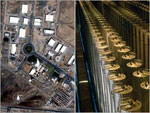 Wall Street Journal: Moves by Iran to deploy more-advanced centrifuge machines for the production of nuclear fuel are raising new concerns that Tehran could significantly shorten the time it would need to produce nuclear bombs.
Wall Street Journal: Moves by Iran to deploy more-advanced centrifuge machines for the production of nuclear fuel are raising new concerns that Tehran could significantly shorten the time it would need to produce nuclear bombs.
The Wall Street Journal
By JAY SOLOMON
 WASHINGTON—Moves by Iran to deploy more-advanced centrifuge machines for the production of nuclear fuel are raising new concerns that Tehran could significantly shorten the time it would need to produce nuclear bombs.
WASHINGTON—Moves by Iran to deploy more-advanced centrifuge machines for the production of nuclear fuel are raising new concerns that Tehran could significantly shorten the time it would need to produce nuclear bombs.
In recent weeks, the Atomic Energy Organization of Iran has notified United Nations inspectors that it has begun deploying what are described as second- and third-generation centrifuges at its uranium-enrichment facility in the city of Natanz, according to diplomats briefed on the correspondence.
Tehran has also said that it plans to set up these advanced machines at an underground uranium-enrichment site run by Iran’s elite military unit, the Islamic Revolutionary Guard Corps, near the holy city of Qom, said these officials. Iran denies it seeks to develop nuclear weapons.
The more-advanced centrifuges, called IR-2Ms and IR-4s, are believed to be capable of enriching uranium at rates three times as fast as those Tehran currently uses, the IR-1s.
Any significant deployment of these machines in the coming months, said U.S. and European officials, could significantly shorten the time, in the Obama administration’s assessment, that Iran could produce the highly enriched uranium needed to create nuclear weapons.
U.S. officials estimate that Tehran would now need 18 months to two years to convert its stockpile of low-enriched uranium—around 4,000 kilograms—into the weapons-grade material for a bomb. A successful deployment of new IR-2M and IR-4 machines could cut this time in half, if not by more, depending on their numbers and efficiency, said these officials.
Nuclear experts estimate Iran has enough low-enriched uranium to produce nearly four bombs, if the material is enriched further to weapons-grade.
U.S. and European officials have said they are concerned about Iran’s recent announcements. “Iran has just staged a new action of provocation by announcing the forthcoming installation of a new generation of centrifuges,” said France’s foreign ministry spokesman.
But there remains skepticism inside the Obama administration that Tehran will be able to deploy the advanced centrifuges in a meaningful way.
“They like to give the impression that they’ve made more advances than they have,” said a senior U.S. official. “I think the progress they are making is more rhetorical than real.”
U.S. intelligence agencies and inspectors from the U.N.’s Vienna-based International Atomic Energy Agency have been fixated on the status of Iran’s advanced centrifuges for at least five years.
Iranian officials have on a number of occasions said they were moving to begin operating cascades of IR-2 machines at Natanz, according to IAEA staff, but never followed through. IAEA officials visited Iranian laboratories in 2006 and saw test models of IR-2 machines that appeared close to operational.
IAEA staff and U.S. officials say they think Iran has so far failed to introduce the machines for technical reasons and as a result of sanctions.
On the technical front, as the machines spin at supersonic speeds and can easily malfunction or break up if not property balanced and configured. International sanctions imposed on Iran by the international community are also seen limiting Tehran’s ability to procure the raw materials needed to build the advanced centrifuges, particularly carbon fiber and high-strength maraging steel. Much of the global supply of these materials comes from U.S. allied countries, such as Japan and Germany.
Iranian officials have told the IAEA that it has begun installing two cascades of advanced centrifuges at the Natanz site, one made of IR-2m machines and the second of IR-4s, according to Vienna-based diplomats. Each cascade is made up of 164 machines and can be used to enrich uranium to levels of either 3.5% or 19.75% purity. Uranium normally needs to be enriched to around 90% purity to be considered weapons-grade.
U.S. and European officials, though, are more concerned about what Iran is planning to do at the site in Qom.
The head of Iran’s Atomic Energy Organization, Fereydoun Abbasi-Davani, in June told the IAEA that Tehran was seeking to triple production of nearly 20%-enriched uranium at the site. Because the Qom facilities are buried under a mountain, they are seen as sheltered from an American or Israeli air attack.
Iran argues that it needs to produce 20% enriched uranium to fuel Iran’s research reactor in Tehran and to develop medical applications. U.S. and European officials say Iran is stockpiling amounts well in excess of what is needed to run the reactor. They also note that technical work required to advance to producing 20% enriched uranium from 3.5% is much more difficult than then advancing to the 90%, weapons-grade level.
“Now the entire program appears geared up to producing 20%-enriched uranium,” said Olli Heinonen, who served as the IAEA’s chief nuclear inspector up until last year. “They are going to higher enrichment in a serious way.”
In a separate development, an Iranian nuclear scientist, Darioush Rezaeinejad, was assassinated last week by two unidentified gunmen in downtown Tehran. He was the third Iranian nuclear scientist killed inside Iran over the past two years.
Iran’s government said Mr. Rezaeinejad wasn’t involved in Iran’s nuclear program. But officials briefed on his work said he was an expert in developing high-voltage switches, which are key components in setting off the explosions needed to trigger nuclear warheads. Mr. Rezaeinejad had written papers on the subject and submitted them to Iranian journals. He was believed to be in his mid-30s, and not necessarily a senior official in Tehran’s nuclear program.


